Data extracted in November 2024.
Planned article update: December 2025.
Highlights
Air passenger transport, 2023 (% change compared with previous year)
Country codes
This article analyses recent passenger data on air transport in the European Union (EU). This data demonstrates the strong recovery of air travel after the COVID-19 pandemic and its restrictions, showing the number of passengers transported.
The article differentiates between national (domestic), intra-EU and extra-EU transport, then examines the significance and ranking of airports.
Number of passengers transported by air increased to 973 million in 2023
To prevent the spread of the COVID-19 pandemic, countries around the world put in place a variety of restrictive measures from the beginning of 2020. The air transport industry was severely hit but the first signs of recovery were observed in 2021. In 2022, an even more pronounced rebound was observed in the aviation sector. The recovery in air travel continued into 2023, with the EU seeing a 19.3% increase in air passengers compared with 2022, reaching a total of 973 million (Figure 1). However, this is still below the pre-pandemic levels observed in 2019 (1 billion passengers). All EU countries registered an increase in passenger numbers carried by air transport compared with 2022. Malta experienced the highest increase (+33.3%), while Slovenia had the second highest (+30.9%). Among the remaining EU countries, 10 recorded an increase between 20% and 30%, and 13 recorded a growth between 10% and 20% over the same period. The two remaining EU countries, Greece and Estonia registered an increase of 9.6% and 7.9%, respectively.
All EFTA and candidate countries also increased substantially in 2023 compared with 2022. North Macedonia recorded the highest growth, by 47.2%, followed by Serbia (+38.5%) and Montenegro (+30.6%).
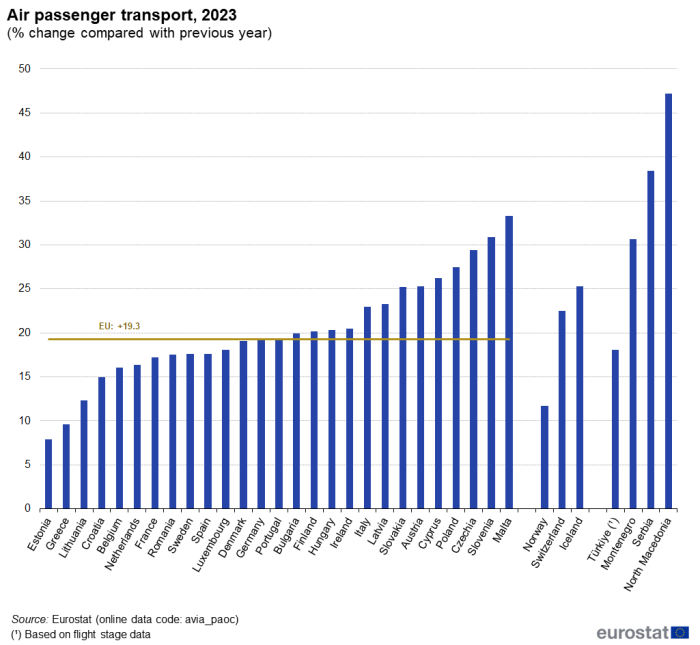
(% change compared with previous year)
Source: Eurostat (avia_paoc)
Figure 2 shows the year-on-year monthly and quarterly growth in air passenger transport for 2023 in the EU. The lingering effects of COVID-19 restrictions in 2022 are evident in the first quarter (Q1) of 2023, marked by a significant 55.3% surge in EU passenger numbers compared with the same period in 2022. This growth reached its peak in January 2023, with a remarkable increase of 81.5%. In the 3 remaining quarters, the number of air passengers carried also increased every month at EU level, but more modestly. The largest increase was observed in April 2023 (+21.3% compared with the same month in 2022). In the remaining months, the increases were between 11.0% in August and 16.7% in May.
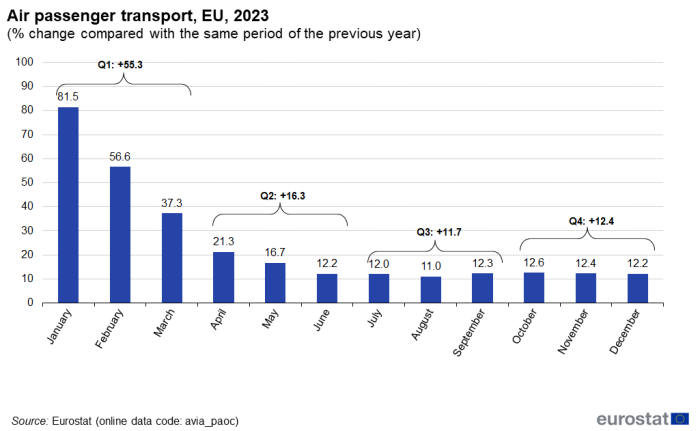
(% change compared with the same period of the previous year)
Source: Eurostat (avia_paoc)
Extra-EU passenger transport dominated in 2023, at 49.0%
Figure 3 indicates that extra-EU transport represented 49.0% of total air passenger transport. This was the main origin/destination, ahead of intra-EU transport (35.9%) and domestic transport (15.0%). Compared with 2022, the share of national and intra-EU transport lost 1.5 percentage points (pp) and 0.5 pp respectively in 2023 to the benefit of extra-EU, which gained 2.0 pp.
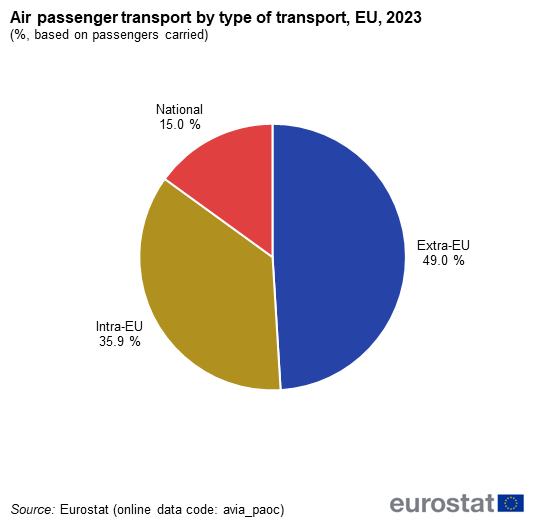
(%, based on passengers carried)
Source: Eurostat (avia_paoc)
All EU countries registered an increase in intra-EU and extra-EU passenger transport. For intra-EU transport, Spain carried the highest number of passengers in 2023 with 110.9 million passengers, and Malta recorded the highest increase of 31.8%, reaching 5.7 million passengers. For extra-EU transport, Germany carried the highest number of passengers in 2023, totalling 80.8 million. Slovenia increased the most by 41.4%, reaching 0.7 million passengers. Among the other EU countries, the lowest increase was registered for Lithuania in terms of extra-EU with +7.1%, while Estonia and Greece recorded the least increases in intra-EU traffic (+6.5% and +8.1%, respectively). Out of the 27 EU countries, 19 increased by more than 20% in terms of extra-EU traffic. The remaining EU countries, (apart from Lithuania), recorded increases between 11% and 19%. For intra-EU traffic, 10 EU countries attained increases of more than 20%. The remaining EU countries, except Estonia and Greece, recorded increases between 13% and 20%. Among all countries, the Netherlands experienced the highest increase in national passenger transport with 6 000 passengers, representing a 45.1% growth. Seven EU countries recorded a drop in domestic passenger transport in 2023 compared with 2022. The largest decrease was observed in Belgium (-60.9%), followed by Slovakia (-29.3%). There was no national transport reported for Latvia, Luxembourg, Malta and Slovenia.
In 2023, international transport activity rose substantially in all EFTA and candidate countries compared with 2022 levels. The highest growth was observed in North Macedonia (+47.2%). When looking at national transport, increases were recorded in the EFTA countries and Serbia. There was no national transport reported by Montenegro and North Macedonia.
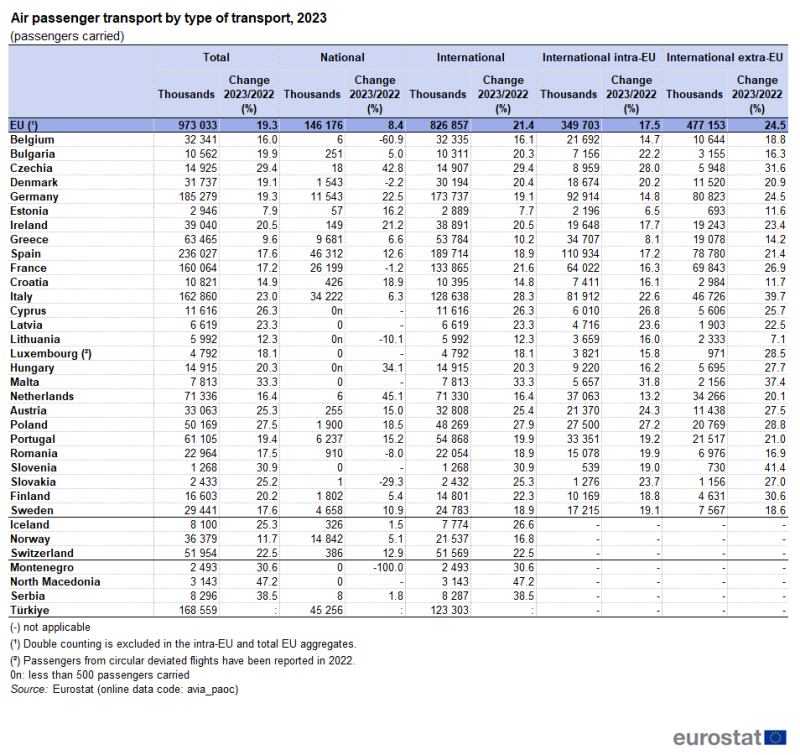
(passengers carried)
Source: Eurostat (avia_paoc)
Table 2 presents the top 10 EU country-to-country flows registered in 2023. Among the top 10 routes, Spain is involved in 5, the most significant one being the traffic between Spain and Germany which represented 21.2% of the top 10 passenger routes and 7.6% of all intra-EU transport. Almost all routes showed a substantial increase between 2022 and 2023 from +11.3% to +29.7%. Traffic between the Netherlands and Spain only increased by 1.0%.
Map 1 gives a picture of the extra-EU market. Europe except EU was the main origin/destination of passengers travelling by air in 2023, with 57.1% of the total extra-EU transport. The lowest shares were observed for Central Asia and Australasia, South Sea Islands and Antarctica (Australasia, S. Sea Is. & Antarctica) (each at 0.1%). Transport with almost all areas in the world increased substantially between 2022 and 2023. In relative terms, the highest increase was recorded for transport with Eastern Asia (+265.0%). Transport with Central America and Caribbean and Australasia, South Sea Islands and Antarctica increased more moderately by 3.1% and 4.1%, respectively.
Table 3 shows that Paris Charles de Gaulle was the largest EU airport, in terms of passengers transported by air in 2023, with 67.4 million). This was followed by Amsterdam Schiphol (61.9 million), Adolfo Suárez Madrid Barajas (60.1 million), Frankfurt Main (59.3 million), Barcelona El Prat (49.8 million) and Roma Fiumicino (40.3 million), the only airports registering over 40 million passengers. When looking at the number of passenger flights, the ranking was slightly different. Amsterdam Schiphol was first with 423 000 flights, followed by Paris Charles de Gaulle (408 000 flights), Frankfurt Main (399 000 flights), Adolfo Suárez Madrid Barajas (365 000 flights), Barcelona El Prat (304 000 flights) and München (285 000 flights).
Passenger numbers increased in all top EU airports in 2023 compared with 2022, ranging from +38.2% in Roma Fiumicino to +7.9% in Lennart Meri Tallin. Of the top 40 EU airports, 19 increased by more than 20%. Similar to the overall trend, passenger flight numbers in all airports experienced an increase in 2023 compared with 2022. The growth varied from a low of +3.4% at Lennart Meri Tallin to a high of +30.74% at Larnaka International.
Map 2 presents the top 10 airport pairs within the EU in 2023. It is worth noting that 6 out of 10 routes were domestic ones. The Barcelona El Prat to Palma de Mallorca route carried the most passengers in 2023, with 2.3 million travellers, representing a 12.2% increase from the previous year. All routes registered increases between 2022 and 2023, except for the Paris Orly to Nice Côte d'Azur connection, which decreased by 9.5%. The highest increase was recorded for the Adolfo Suárez Madrid Barajas and Roma Fiumicino connection (35.9%).
Even in 2021, the COVID-19 pandemic's effect on passenger transport is evident, with significantly fewer passengers travelling to and from non-EU countries compared with 2022 and 2023, across all travel distances. In particular, for the 300-499 km distance band, the share of extra-EU was 22.0% in 2021 and increased to 32.2% in 2022 and 33.5% in 2023. National traffic benefited mostly from this situation in 2021, with higher shares of national traffic on all distance bands in 2022 and 2023 compared with 2021, in particular, for distance bands under 1 000 km. The share of national traffic represented 85.4% of total traffic in 2021 for distances below 300 km, compared with 77.7% in 2022 and 74.7% in 2023, a 10.7 pp decrease between 2021 and 2023. The share of national traffic for the 300-499 km distance band decreased by 15.5 pp between 2021 and 2023, while for the 500-999 km distance band, this share decreased by 14.9 pp. The share of intra-EU traffic was the highest for distance bands between 1 000 km and 2 000 km in 2021.However in 2022 and 2023, the share of intra-EU traffic was also the highest for the 500-999 km distance band, surpassing national traffic.
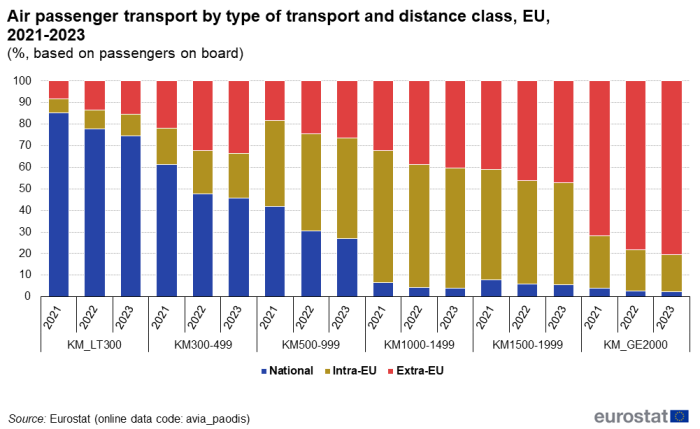
Source: Eurostat (avia_paodis)
Source data for tables and graphs
Data sources
More recent passenger data are available in the Eurostat database for a number of countries, Eurostat is encouraging reporting countries to provide statistics on passenger transported by air in advance of the regulatory deadline. For some countries the data are available already up to 3 months after the end of a reference month.
Main definitions
The definitions used for air transport statistics are included in Regulation (EC) No 1358/2003 of 31 July 2003 implementing Regulation (EC) No 437/2003 of 27 February 2003 on statistical returns in respect of the carriage of passengers, freight and mail by air. The main definitions are the following:
- On Flight Origin and Destination (OFOD): Traffic on a commercial air service identified by a unique flight number subdivided by airport pairs in accordance with the point of embarkation and point of disembarkation on that flight. This is linked to the definition of passengers carried.
- Passengers carried: All passengers on a particular flight counted once only and not repeatedly on each individual stage of that flight. This excludes direct transit passengers.
- Airport coverage: In principle, this article covers air transport to and from any airports in the reporting countries with more than 150 000 passengers annually.
Notes on some reporting countries
- Türkiye: until 2022, only provides flight stage data (Dataset A1) (in which there is no information on passenger carried and freight and mail loaded/unloaded) and airport declarations (Dataset C1) in which the partner airport is not provided. National and international transport cannot be calculated.
Double counting: the national aggregates and total intra-EU aggregates exclude any double counting. It includes all the departures figures reported plus "a part of" arrivals declarations, "a part of" including those arrivals declarations for which the corresponding departures declarations of the partner airport are missing.
Table 1: the figures (and related shares) for the country-country flows have been calculated by excluding the double counting at country-to-country route level. The figures are derived from table avia_paocc; the double counting for identical routes is excluded in order to obtain the correct total for country pairs. The data can be extracted from the aviation domain of the Eurostat online database or obtained upon request.
Map 1: the component countries comprising the world regions as defined for this map are based on the geonomenclature used by Eurostat for external trade statistics. The components of each world region can be extracted from the aviation domain of the Eurostat online database or obtained upon request. Care should be taken in drawing any conclusions as regards world regional shares due to the fact that passengers who either stop-over or change planes en-route will be allocated to the country in which they made their connections and not to the country of first origin or final destination.
Map 2: the total figures for each pair of airports have been calculated by adding together the 'Departures' declarations of the two airports concerned.
In this article
- ":" means "not available"
- "-" means "not applicable"
- "0n" means "less than half the unit used"
- "0" means real zero
Context
All figures presented in this article have been extracted from the Eurostat aviation database. The database is available online from the Eurostat web page.
Explore further
Other articles
Database
- Transport, see detailed datasets:
- Air transport (avia)
- Air transport measurement - passengers (avia_pa)
- Detailed air passenger transport by reporting country and routes (avia_par)
- Air transport measurement - freight and mail (avia_go)
- Air transport measurement - passengers (avia_pa)
Thematic section
Publications
Selected datasets
- Transport, see selected datasets:
- Air transport (t_avia)
- Air transport of passengers (ttr00012)
- Air transport of goods (ttr00011)
Methodology
- Passenger and freight transport by air/Traffic data/Air transport at regional level (ESMS metadata file - avia_pa_esms)
- Reference Manual on Air Transport Statistics - Version 17 (Methodological manual)
- Glossary for transport statistics - 5th edition - 2019
External links
Legislation
- Regulation (EC) No 1358/2003 of 31 July 2003 implementing Regulation (EC) No 437/2003 of 27 February 2003 on statistical returns in respect of the carriage of passengers, freight and mail by air.




